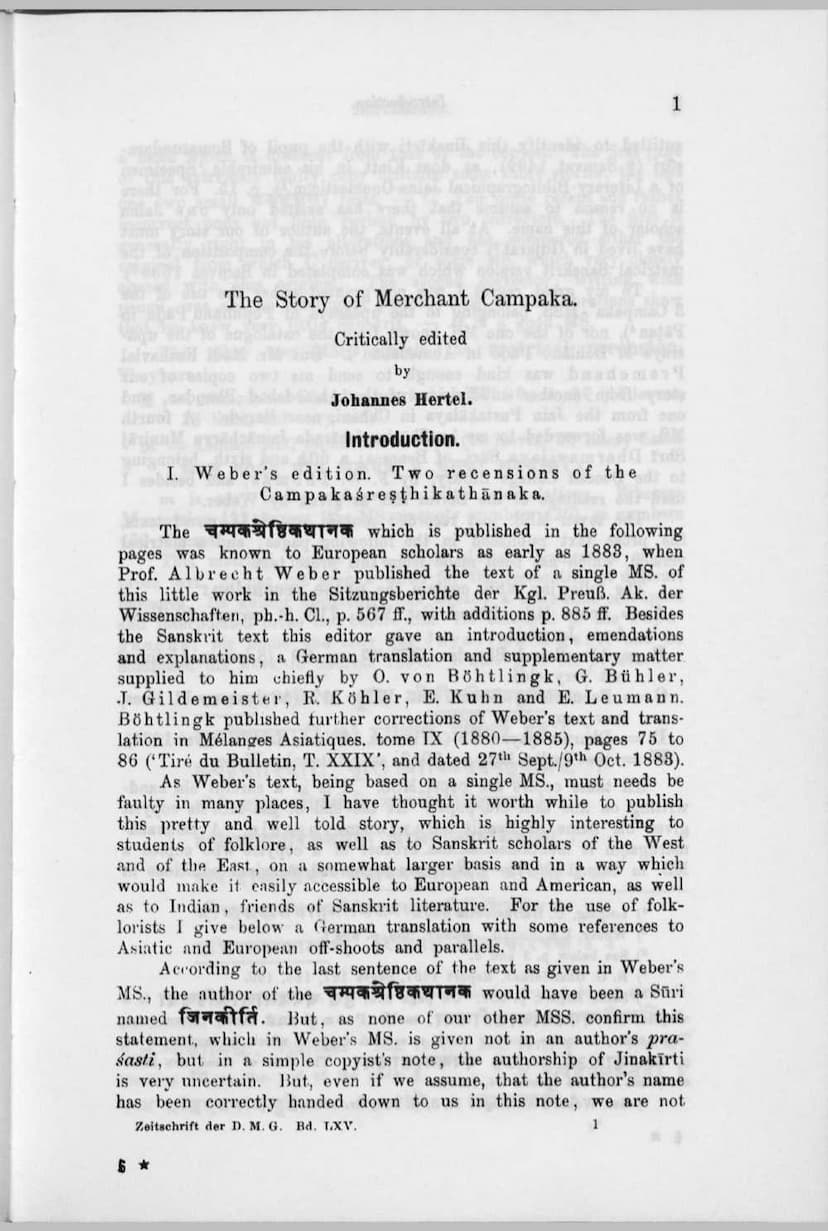Story Of Merchant Champaka
Added to library: September 2, 2025
Loading image...

Summary
This document is the critical edition of the "Story of Merchant Campaka" (Campaka śreṣṭhikathānaka), edited by Johannes Hertel. The introduction outlines the scholarly history of the text, its manuscripts, and the editorial principles employed.
Here's a breakdown of the key points from the introduction:
I. Weber's Edition and Two Recensions:
- Previous Publication: Professor Albrecht Weber published a Sanskrit text of the story in 1883, based on a single manuscript. This edition included an introduction, emendations, a German translation, and supplementary material provided by other scholars.
- Hertel's Motivation: Hertel found Weber's edition, based on a single manuscript, to be potentially flawed. He aimed to provide a more comprehensive and accessible edition for both Western and Eastern scholars of folklore and Sanskrit.
- Two Recensions: Hertel identifies two main recensions of the story:
- Prose Recension: This is the primary text published in the following pages.
- Metrical Version: A versified adaptation of the prose text, composed by Jayavimala-gani in Samvat 1658. Hertel notes that this metrical version is generally a slavish adaptation and doesn't significantly aid in correcting the prose text, possibly because Jayavimala worked from a corrupted prose version.
II. Manuscripts Used for the Edition:
- Manuscript Sources: Hertel utilized seven manuscripts for his edition. He gratefully acknowledges the assistance of Mr. Modi Keshavlal Premchand and Shastravisharada-Jaināchārya Munirāj Shrī Dharmavijaya Sūri in providing these manuscripts.
- Manuscripts of the Prose Recension:
- A (Poona MS.)
- B (Ahmedabad Bhandar MS.)
- C (Poona MS.)
- D (Dharmavijaya's MS.) - dated Samvat 1631.
- W (Berlin MS.) - the one used by Weber.
- Manuscripts of the Metrical Recension:
- M (Ahmedabad Bhandar MS.)
- m (Chhani MS.) - dated Samvat 1962.
- Dating and Origins: The prose recension is considered considerably older than the metrical version, with Manuscript D dating to 1631 Samvat, predating the metrical version (Samvat 1658). The author of the prose text lived in Gujarat before Samvat 1653.
- Authorship Uncertainty: The author's name, possibly Jinakirti or Jagaita, is uncertain as it appears in a copyist's note rather than an author's prasasti (dedicatory inscription), and other manuscripts don't confirm it.
III. Editorial Principles:
- Basis of the Text: The edition is based on the prose recension manuscripts (A, B, C, D, W).
- Critical Approach: Hertel aimed to produce an emended text of the archetype of these manuscripts. He prioritized readings supported by multiple manuscripts and deviations were made only when readings were clearly erroneous.
- Manuscript Relationships: Hertel meticulously traces the relationships between the manuscripts, creating a pedigree to show their likely lineage from the author's original. He notes common mistakes that indicate intermediate copies.
- Inclusions and Exclusions:
- Glosses: Hertel identifies and addresses glosses that have crept into the text from previous manuscripts.
- Additions in Manuscript A: Manuscript A contains several additions, often from glosses, which Hertel identifies and indicates were not part of the original text.
- Blunders: Hertel emphasizes the importance of recording manuscript blunders, as they are crucial for understanding manuscript relationships and for future critical work.
- Clerical Errors: Minor clerical errors occurring in only one manuscript and not affecting the reading are generally neglected.
- Specific Editorial Decisions: The introduction details specific instances where Hertel had to make editorial choices, such as resolving name variations (e.g., Vriddhadatta vs. Vādhū) and prioritizing readings based on grammatical correctness and consistency with the metrical version.
- Quoting Conventions: Numbers of tales are in Roman numerals in the margin, and section numbers are in Arabic numerals.
In essence, the introduction to Johannes Hertel's critical edition of the "Story of Merchant Campaka" establishes the scholarly context, details the textual evidence (manuscripts and recensions), and explains the rigorous methods employed to reconstruct the most accurate version of this Jain narrative.